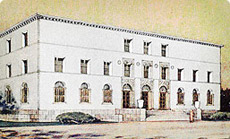|

 In 1937, Shibusawa Keizo presented his proposal for a museum of Japanese business history to the Ryumonsha (a foundation originally established by Shibusawa Eiichi in 1924 and now known as the Shibusawa Eiichi Memorial Foundation). His original proposal, entitled Hitotsu no Teian (A Proposal), included the following passages (translated from the original Japanese). In 1937, Shibusawa Keizo presented his proposal for a museum of Japanese business history to the Ryumonsha (a foundation originally established by Shibusawa Eiichi in 1924 and now known as the Shibusawa Eiichi Memorial Foundation). His original proposal, entitled Hitotsu no Teian (A Proposal), included the following passages (translated from the original Japanese).
Mission:
 |
“Whereas the advancement of the culture of a nation and its people may be measured in the quality of its museums. . . we hereby seek to construct a museum of the modern history of the economy here on the grounds of Aiison-so.
As yet no plan has been found for a museum on the economy focusing on materials relating in particular to the remarkable and epochal changes of our people in the period of transition from the end of the Tokugawa regime to the launching of the Meiji state in 1868. We would leave to other institutions the creation of exhibits on themes of economic history prior to modern times, which are often difficult to separate from other aspects of basic culture. We would also leave to a museum of industry yet to be built artifacts of modern industry resulting from the application of recent science and technology. Thus the historical museum of the modern economy that we propose to construct would be concerned with the period beginning just before the birth of Shibusawa Eiichi (1840) and extending to the end of the Meiji era (1912), an epoque that coincides with a phase of dramatic economic development of the nation.” |
Size and content:
- Seien Memorial Hall (333 square meters)
 |
“Through exhibits of treasured mementos, photographs, writings (including examples of handwritten and published works), architectural models, dioramas, and various charts and illustrative materials, a chronology of Eiichi's life should be displayed. This should be done in order to vividly illustrate the many changes as well as the continuities that characterized his multifaceted career. This room should cover all aspects of his activities, not only as a businessman but also as a leader in education, international friendship, labor issues, and philanthropy.” |
- Hall of Modern Economic History (1,485 square meters)
 |
“The following items are to be chosen and displayed for business education and social edification: basic sources showing the scale, degree, and direction of the changes and developments of Japanese economic history from the Bunka-Bunsei eras (1804-30) to the end of the Meiji era (1868-1912); sources related to transformations as a result of and reactions to the introduction of new cultures; artifacts important to the history of business; and articles to be displayed in an especially interesting manner. This being the case, the majority of matters relating to military affairs, diplomacy, politics, scholarship, the arts, religion, aristocratic culture, as well as popular culture need not, in principle, be considered for the collection, except when deemed necessary. Books and other documentary artifacts are to be entrusted to the Seien Bunko (Seien Library).” |
- Portrait Gallery (165 square meters)
 |
“Portraits of all those persons, without distinction as to the scale of their achievements and irrespective of rank and social status, who contributed to the development of Japan's modern economy should be collected and framed for display. The subjects should include businessmen, entrepreneurs, industrialists, manufacturers, agriculturists, mine operators, fisheries operators, scholars, critics, inventors, innovative farmers, and others. The portraits, accompanied by full identifying and biographical information, should be classified by category and put on display to encourage respect for and gratitude to our forebears. This room is to be a gallery of the famous useful in furthering the purposes of community and adult education.”
|

| 1937 |
Idea for museum proposed by Shibusawa Keizo
Ryumonsha approves plan for Museum of Japanese Business History (MJBH) in commemoration of Shibusawa Eiichi
Acquisitions for museum collection begin. |
1939
|
May 13 Site-purification ceremony held at Aiison-so, Shibusawa family estate (Nishigahara, Tokyo) |
| 1941 |
Postponement of construction due to outbreak of Pacific War |
| 1943 |
Preparations Office and collection moved to Sakatani residence in Koishikawa, Tokyo |
| 1945 |
Sakatani residence requisitioned by Allied Occupation |
| 1962 |
Collection entrusted and later donated to what is now the Department of Historical Documents, National Institute of Japanese Literature (formerly Ministry of Education Historical Archives) |
| 1982 |
Shibusawa Memorial Museum founded |
| 2002 |
Digitization of collection of former Museum of Japanese Business History Preparations Office |
|
|